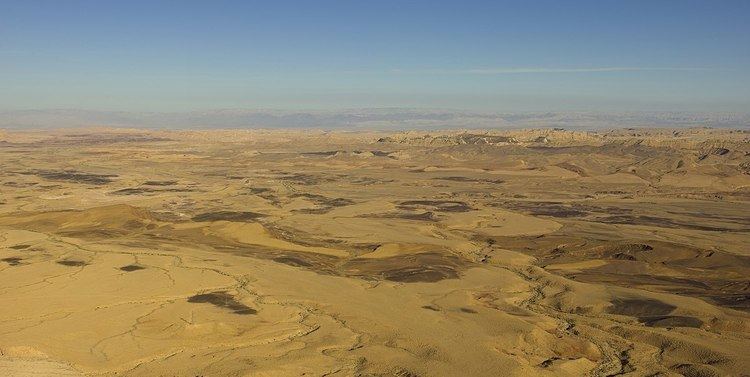 | ||
A makhtesh (Hebrew: מַכְתֵּשׁ ([maχˈteʃ]), plural: מַכְתְּשִׁים ([ˈmaχtəˌʃim] – Makhteshim) is a geological landform considered unique to the Negev desert of Israel and the Sinai peninsula of Egypt. A makhtesh has steep walls of resistant rock surrounding a deep closed valley which is usually drained by a single wadi. The valleys have limited vegetation and soil, containing a variety of different colored rocks and diverse fauna and flora. The best known and largest makhtesh is Makhtesh Ramon.
Contents
Etymology
Although commonly referred to as "craters," these formations are "erosion cirques" (steephead valleys or box canyons). Craters are formed by the impact of a meteor or volcanic eruption, whereas makhteshim are created by erosion.
The word makhtesh is the Hebrew word for a mortar grinder (מַכְתֵּשׁ). The geological landform was given this name, because of its similarity to a grinding bowl.
Geology
Where a hard outer layer of rock covers softer rocks, erosion removes the softer minerals relatively quickly, and they are washed away from under the harder rock. The harder rocks eventually collapse under their own weight and a crater-like valley structure is formed. In Negev and Sinai makhteshim, the hard rocks are limestone and dolomite, while the inner softer rocks are chalk or sandstone.
The center of the Negev is dominated by northeast-southwest anticlinal ridges. The crests of four ridges host five deep valleys surrounded by steep walls. The upper half consists of hard limestone and dolomite and the bottom of friable sandstone. Each valley, known as a makhtesh, is drained by a narrow river bed.
Negev
The Negev has five makhteshim: Makhtesh Ramon; Makhtesh Gadol; Makhtesh Katan; and two small makhteshim on Mount Arif, south of Makhtesh Ramon.
Sinai
The two makhteshim in Sinai, Egypt, have no names for the basin, but their walls have several names including Jabal al-Manzur or Gebel Maghara.
